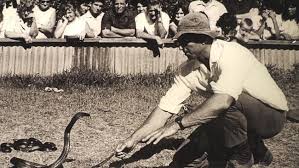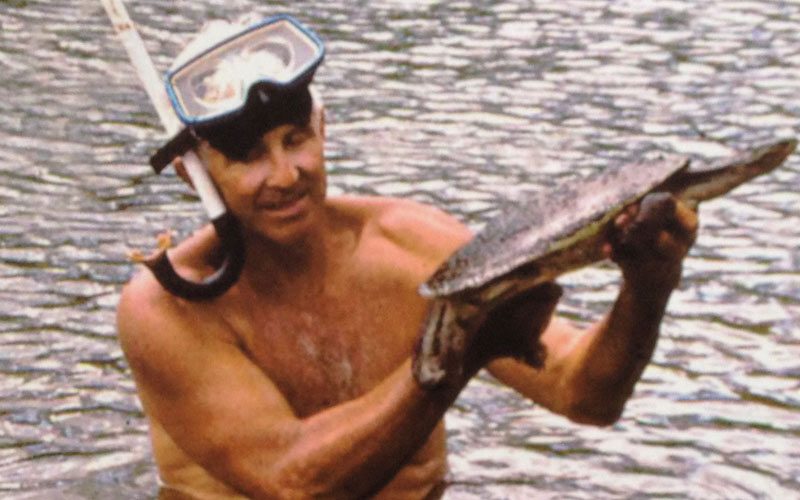Discovery of the Mary River Turtle
John Cann was an Australian Olympic athlete, a state rugby league footballer, a state boxer, an adventurer and became a world authority on turtles. John came from a family of show people. He was introduced to reptiles at an early age by his father George Cann, a reptile showman who entertained and informed generations of visitors at the La Perouse snake pit, a show given by the Cann men for over a century. George later became the Curator of reptiles at Sydney’s Taronga Park Zoo. As a boy, John excelled at athletics, at 18 he represented Australian in the decathlon at the 1956 Melbourne Olympic games. He later played rugby league for New South Wales. He was a keen diver and never lost an opportunity to explore and dive the river country of eastern Australia. John discovered several new turtle species. He has had numerous papers and books published on freshwater turtles. In 1992 John was awarded the medal of the Order of Australia (OAM). He has been acknowledged worldwide for his achievements in the study of turtles.

Here’s the story of the discovery of the Mary River turtle as told by John.
“Of all the turtles I’ve named or discovered, the one that may be my proudest achievement is a turtle that was utterly common place yet took me on a quarter-century long quest to reveal its origins. This was the so-called ‘pet-shop’ turtle, hatchlings of which I’d first noticed in Sydney shops in the early 1960s. I later learnt it had also been sold in Brisbane, Melbourne, and Adelaide. Its natural habitat remained a mystery however, and a puzzle I was determined to solve. When I first began my inquiries, I was told they were imported from the Torres Strait. This seemed possible but unlikely, and after seven or eight years I rejected that theory.
By the late 1960s I was sure the pet-shop turtle was not closely related to the saw-shell turtles (Elseya latisternum) as claimed by most experts and shopkeepers. John Legler, an American turtle scientist and I gave it the name ‘short-neck alpha’. We both became convinced it came from Queensland, although Legler later considered it to be a possible native of Papua New Guinea. In an effort to get more information, I tried to break the pet trade ‘code of ethics’. Pet shops rarely if ever, revealed who supplied them with animals, partly because they didn’t want anyone to set up in competition.
I mentioned the ‘short-necked alpha’ in an article in the GEO: Australian Geographic magazine. The search was sure to hot up now that dedicated herpetologists came to realise they had an interesting undescribed turtle in their collections.
It seemed my annual holidays of four to five weeks weren’t long enough for a thorough search, although several three- and four-day trips allowed me to eliminate some possible locations nearer the ocean. When one of my contacts gave me a likely location in north Queensland, I was unable to check it out. Legler did, but the 4,000 km round trip failed to locate any turtles. By the early 1980s my search was twenty frustrating years old.

A breakthrough came when a wildlife enthusiast found a largish short-neck alpha in perfect shape and condition in Sydney’s Centennial Park. A Melbourne aquarium proprietor suggested I try searching a lake near Swan Hill in northern Victoria. It was another false lead, but this time the round trip was only 2,000km! By this stage, the map I was using of Australia’s drainage system had been almost obliterated by scribbled comments, crosses and question marks.
In 1987 I finally managed to track down a Victorian pet-shop owner who was now out of the trade. He gave me the name of the Sydney contact from whom he received the turtles. A fortnight later he told me the turtles were sent from southern Queensland as I suspected, they arrived around Christmas each year, and he would be back in touch after he’d spoken to his supplier. I was over the moon. I contacted the supplier who was quite polite and finally gave me the location for the short-necked alphas in the bore drains around the town of Bollon in south-west Queensland. Of all the locations visited in my long search, this one excited me the most. It was in Queensland, in dirty water, and where little research had been carried out. Since annual holidays are never long enough, I arranged some unpaid leave. After 2,500 km of hard driving, I visited the Condamine River, but the water was clouded, and the water temperatures were probably too low for turtles, so it would have to wait for another trip. Meanwhile, I’d made arrangements to spend time in 1989 checking out much of the Gulf and Cape York. On our way home, I visited the supplier, John Greenhalgh in Maryborough. For weeks I’d been rehearsing this meeting in my mind. The more he spoke, the more I realised he knew about this turtle which he called ‘black head’ referring to the dark cap on its crown. John said he’d show us some eggs. I still had my reservations about the Mary River as I’d dived there earlier as had many others. My adrenaline was pumping as we prepared to dive. The water was extremely cloudy from the sand-dredging upstream. We dived for about an hour, but in vain. During the following months, I kept in touch with John and a bond seemed to develop between us. John told me of up to 15,000 hatchlings being incubated each year for the pet trade. With about 16 to a nest, there had to be enough adults in the river for me to find one.
In August 1990, my wife Helen and I left Sydney for a 12-week round-Australia trip to photograph turtles and their locations. I’d planned to reach the Mary River in late October. When we arrived in Humpty Doo in the Northern Territory, there was a note waiting for me. ‘I’ve got one’ John had written. We cut a week off our itinerary and headed straight for Maryborough. I was as excited as it’s possible to feel while still harbouring some apprehension. A search that had lasted for more than a quarter of a century was coming to an end. John greeted us, took me to a large drum in which he kept the turtle and removed the lid. My heart sank. Inside there was just a northern snapping turtle. I thought of all the kilometres I’d clocked up over so many years. I was speechless with disappointment. John held a straight face for about 10 seconds then, with a grin, said, ‘Well, if that’s not him, look in this drum.’ It’s hard to convey my feelings when I first looked at an adult pet-shop turtle. At last I was able to pick up one of the creatures I’d been searching for since the early 1960s. Next morning, we were back on the Mary. John rowed while I dived. Visibility was restricted. After a late lunch, I walked a few hundred metres downstream with a pair of binoculars. I could see two large turtles basking on a log and sure enough, made a positive identification. The pet-shop turtle – John Greenhalgh’s ‘black head’ – was native to the Mary River. The search was over. “

